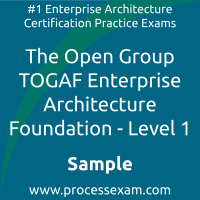 You have to pass the OGEA-101 exam to receive the certification from Open Group. To increase the effectiveness of your study and make you familiar with the actual exam pattern, we have prepared this Open Group TOGAF Enterprise Architecture Part 1 sample questions. Our Sample The Open Group TOGAF Enterprise Architecture Part 1 Practice Exam will give you more insight about both the type and the difficulty level of the questions on the Open Group TOGAF Enterprise Architecture Foundation exam.
You have to pass the OGEA-101 exam to receive the certification from Open Group. To increase the effectiveness of your study and make you familiar with the actual exam pattern, we have prepared this Open Group TOGAF Enterprise Architecture Part 1 sample questions. Our Sample The Open Group TOGAF Enterprise Architecture Part 1 Practice Exam will give you more insight about both the type and the difficulty level of the questions on the Open Group TOGAF Enterprise Architecture Foundation exam.
However, we are strongly recommending practice with our Premium The Open Group TOGAF Enterprise Architecture Foundation - Level 1 Practice Exam to achieve the best score in your actual Open Group OGEA-101 Exam. The premium practice exam questions are more comprehensive, exam oriented, scenario-based and exact match of The Open Group TOGAF Enterprise Architecture Part 1 exam questions.
Open Group TOGAF Enterprise Architecture Part 1 Sample Questions:
01. Which Architecture Domain is normally the first activity undertaken in a Architecture Development Method (ADM) cycle?
a) Application Architecture
b) Technology Architecture
c) Data Architecture
d) Business Architecture
e) Strategic Architecture
02. How do Architecture Building Blocks (ABBs) contribute to the development of an organization's architecture?
a) By increasing the complexity of the architecture
b) By providing a standardized set of components that can be used to construct solutions
c) By automating all architectural tasks
d) By reducing the number of stakeholders involved in architecture decisions
03. According to the TOGAF Standard, where should Architecture Governance activities be recorded within the Architecture Repository?
a) Architecture Capability
b) Architecture Metamodel
c) Governance Repository
d) Reference Library
e) Solutions Landscape
04. Views and Viewpoints are used by an architect to capture or model the design of a system architecture. Which of the following statements is true?
a) Every view has an associated viewpoint that describes it, at least implicitly.
b) A viewpoint is always specific to the architecture for which it is created.
c) Different stakeholders always share the same views.
d) Different stakeholders always share the same viewpoints.
05. Which of the following is defined as a formal description of one state of the architecture at an architecturally significant point in time?
a) Baseline Architecture
b) Target Architecture
c) To-Be Architecture
d) Transition Architecture
e) As-Is Architecture
06. During the Vision Phase of Enterprise Architecture, which document is typically created to define the overall vision and goals for the architecture project?
a) Architecture Vision document
b) Architecture Definition Document
c) Detailed technical specifications
d) Enterprise budget report
07. In Enterprise Architecture, what is the role of an Architecture Framework in the context of an Architecture Repository?
a) To create detailed software code
b) To provide a comprehensive list of software applications
c) To define a standardized approach for creating and managing an organization's architecture
d) To conduct employee training sessions
08. What class of architectural information within the Architecture Repository defines processes that support the governance of the Architecture Repository?
a) Reference Library
b) Architecture Requirements Repository
c) Architecture Metamodel
d) Governance Repository
e) Architecture Capability
09. Why is it important to use iteration when applying the TOGAF Architecture Development Method (ADM)?
a) Iteration enables the capture of stakeholder requirements through the ADM cycle.
b) Iteration supports the selection of alternative Target Architectures.
c) Iteration supports returning to previous phases to update work products with new information.
d) Iteration helps identify Business Scenarios to choose from.
10. The Open Group Architecture Framework has a modular structure. Which parts the TOGAF Standards consists of?
a) The TOGAF Standard, TOGAF Fundamental Content, TOGAF Series Guides, TOGAF Library
b) Architecture Continuum, Solutions Continuum, Enterprise Continuum, Deployed Solutions
c) Architecture Landscape, Solutions Landscape, Standards Library, Architecture Capability
d) Architecture Vision, Business Architecture, Information Systems Architecture, Technology Architecture
Answers:
Question: 01
Answer: d |
Question: 02
Answer: b |
Question: 03
Answer: c |
Question: 04
Answer: a |
Question: 05
Answer: d |
Question: 06
Answer: a |
Question: 07
Answer: c |
Question: 08
Answer: e |
Question: 09
Answer: c |
Question: 10
Answer: a |
If you find any errors or typos in The Open Group TOGAF Enterprise Architecture Foundation - Level 1 (OGEA-101) sample question-answers or online Open Group TOGAF Enterprise Architecture Foundation practice exam, please report them to us on feedback@processexam.com
 You have to pass the OGEA-101 exam to receive the certification from Open Group. To increase the effectiveness of your study and make you familiar with the actual exam pattern, we have prepared this Open Group TOGAF Enterprise Architecture Part 1 sample questions. Our Sample The Open Group TOGAF Enterprise Architecture Part 1 Practice Exam will give you more insight about both the type and the difficulty level of the questions on the Open Group TOGAF Enterprise Architecture Foundation exam.
You have to pass the OGEA-101 exam to receive the certification from Open Group. To increase the effectiveness of your study and make you familiar with the actual exam pattern, we have prepared this Open Group TOGAF Enterprise Architecture Part 1 sample questions. Our Sample The Open Group TOGAF Enterprise Architecture Part 1 Practice Exam will give you more insight about both the type and the difficulty level of the questions on the Open Group TOGAF Enterprise Architecture Foundation exam.